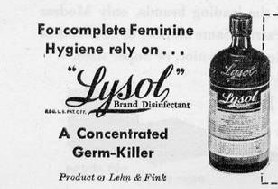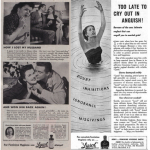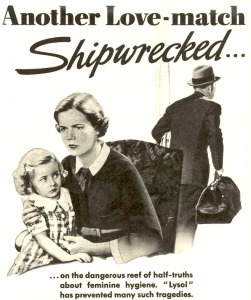
One of the tame Lysol ads. Many campaigns sought to shame and embarrass women into using Lysol for feminine hygiene.
Go check out that can of Lysol in your bathroom. Read the back of the label. See where it says “Kills herpes”? Disregarding the fact that you can’t actually kill a virus – they aren’t alive to begin with – there’s a very good reason it’s on your can of bathroom disinfectant: for the first half of its life, that product was marketed to women as a feminine hygiene douche. And although not directly marketed as such, Lysol was – from 1920 to the advent of actual birth control pills in 1960 – the #1 birth control agent in the country and many unsuspecting women poisoned, maimed themselves and even died in the process.
Marketed under the proprietary name Lysol since the 1890’s, the disinfectant – first used for antisepsis – was popularized in the 1920’s by Lehn & Fink’s advertising blitz which targeted women and highlighted the product’s versatile “disinfectant properties”. In truth, Lysol was a caustic poison and in more concentrated form was retailed with the prominent skull and crossbones icon. Ingested, it could kill; applied externally, it irritated and burned. Lehn & Fink sold it for feminine hygiene anyway, ignoring recommendations made by the 1912 council on Pharmacy & Chemistry of the AMA that companies not advertise to the laity any disinfectants, germicides and antiseptics for application to the eye, gastrointestinal tract or genitourinary tract. By 1911, doctors had recorded 193 Lysol poisonings, including 21 suicides, 1 homicide and 5 deaths from uterine irrigation.
Suicide by Lysol wasn’t at all uncommon, it seems. According to The Argus of Melbourne, Lysol was Australia’s most fashionable means of suicide in 1911.
In 1915, a Chicago man accidentally killed his wife, who had just given birth, by confusing her Lysol with her actual medicine and giving her the toxic substance to drink. As Lysol became more commercially widespread, injury and death rates grew. Coroners in New York City reported 40 suicidal and 4 accidental deaths in 1925 alone. As evidence about the hazards or its antiseptic douche mounted, Lehn & Fink continued to deny wrongdoing and to refuse to admit that it was in the contraceptive business. But it changed formulas in 1952, to substitute orthohydroxydiphenyl for cresol, which some researchers had come to believe was carcinogenic. FDA bacteriologists fond the new solution to be “about 1/4 as toxic as the old” but still potentially lethal if swallowed by a young child. The change left Lehn & Fink free to advertise Lysol as a germicide – a fact FDA scientists could not refuse – “ideal for toilet bowl, ringworm and sunburn and as an antiseptic douche for feminine hygiene. The new-and-improved solution did not shield women from injury or pregnancy. In 1961, a Lysol douche caused one woman’s vagina to blister and bleed. Her husband, armed with her physician’s report, complained to Lehn & Fink. The company’s president admitted that feminine hygiene had long been one of Lysol’s “major applications.” he boasted that “millions of [Lysol] douches are being applied at regular intervals” across the country. What was astonishing was the company’s defense. “Your report is the first of its kind on record,” he informed the husband, in a striking example of corporate amnesia.
Although technically never marketed as such, Lysol would remain the leading female contraceptive in the US until 1960 when a new product – oral contraceptives – would finally dethrone it and send it reeling into history and forcing them to find a new use for Lysol. That can of bathroom cleaner under your sink.
Throughout its life, Lysol had been a leading method of poisoning (and suicide), as people honestly didn’t understand what was truly good and/or bad for them. “If germs are bad and Lysol kills germs, then drinking Lysol should kill my germs, and that’s good for me, right?” To this very day, the very same flawed logic persists in a fair share of the general public – only knowing enough to be a danger to themselves. Their ignorance also makes them an easy target for snake oil salesmen peddling miracle cures; then and now (the Internet is full of snake oil sites and ads). This is the very reason why government regulation and agencies such as the FDA came to exist… and when it comes to reasons for such regulations, stories such as Lysol’s are but a drop in the bucket; some are much, much worse.
in order to help increase public health and safety, ProjectAccept.org is assisting the FDA by helping to hunt down and eliminate those who make fraudulent & dangerous HSV & HPV treatment and cure claims.
Sources:
Tone, A. (2002). Devices and desires: a history of contraceptives in America.
LYSOL POISONING. FASHIONS IN SUICIDE. (1912, January 10). The Argus (Melbourne, Vic. : 1848 – 1957), p. 11.









